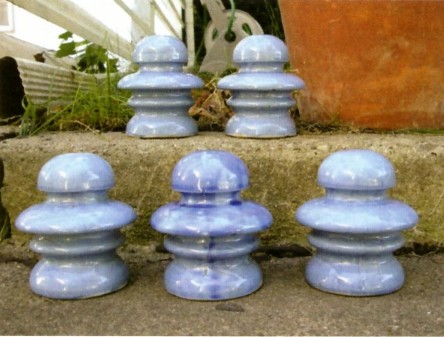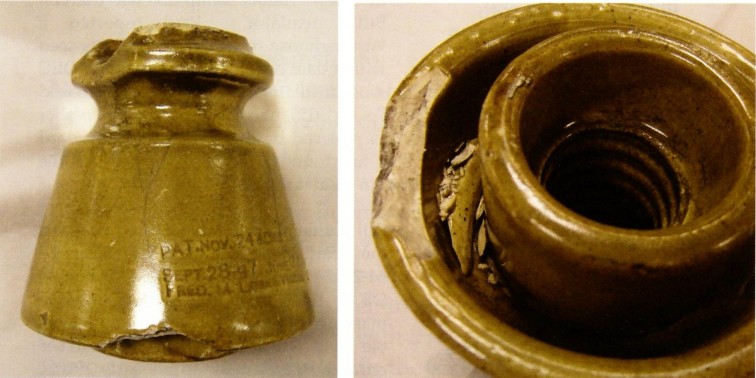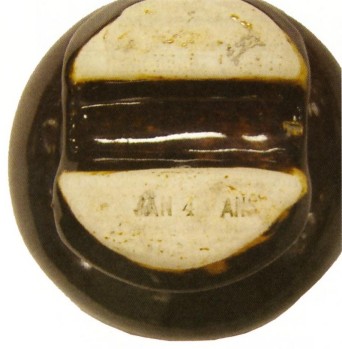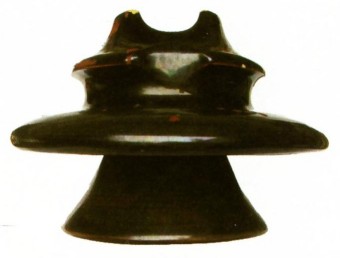Porcelain Insulator News
By Elton Gish
Reprinted from "Crown Jewels of the Wire", April 2006, page 18
As promised in the last PIN, here are a bevy of beautiful blue Pittsburg U-202A's.
Joe Warmuth actually owns five of them, but the photo I liked best
only shows four. The one on the right is unique in that it has a nice mottling
of darker blue in streams from the top down as if that color was poured on
afterward. The blue glaze on the U-202A is probably the prettiest blue ever
produced and unlike any glaze found on other styles made by Pittsburg in the
1910's. Many specimens are crude and often have fingernail-size flakes missing
on the underside of the upper skirt that have been glazed over. Joe is rightly
proud of his collection of blue U202A's. He certainly lives in the right part of
the country - near Waterloo, Iowa - where most if not all have been found.

U-202A's

Matt Poage reported a very unusually marked insulator. The style is U-7. The
skirt has an embossed reverse marking composed of two handwritten letters: H. N.
There are "initial strokes" on each letter and the "N" is a
lower case letter. We can only assume it is a person's initials, but in order to
make the letters embossed (raised), they would have had to scratch the letters
into the mold. That means every insulator made in that mold would have those letters.
I suspect the mold was worn out and about to be replaced with a new one, or
perhaps that style was being discontinued and someone wanted to make a few
personalized insulators at the end of the run. Obviously one escaped the factory
and was used on the line.

Unique U-7
Jeff Katchko usually turns up something odd. At the last Springfield show he
showed me his latest find. While digging an old line between Wilksburg and Scranton, PA looking for third
rail insulators, Jeff
dug up a crude, beautiful U-939C with Fred Locke marking #4-2 and the
manufacturing date of DEC 22 1900. Only one other has been reported, which is
the one I have in my collection. It came from Paul Mohrs many years ago and
quite possibly was used on this same line. The one Jeff found has some surface
cracks. After all it has been buried for nearly 100 years. A very unusual
feature of Jeff's insulator is the large chip on the bottom of the outer skirt.
It was made that way, and the chip and smaller fragments fell down between the
skirts and fused together when the insulator was fired. Undoubtedly the
insulator was chipped while stacking the glazed and fully dried clay insulators
in the kiln. So, Jeff's very lucky dig not only uncovered a very rare insulator,
but one that has a unique factory flaw.

Rare U-939C with Fred Locke marking
and fused chips between the skirts.
Pittsburg insulators can sometimes be found with full date incuse markings
such as DEC 11 1917. That is the actual day the insulator was made. They also
used various date codes such as the following six types:
| FEB 18 A.M. |
JAN 18 Ent'd |
| APR 12 P.M. |
AUG 9 Ans'd |
| JAN 17 PAID |
SEP 20 Rec'd |
You can see the current listing of the reported markings at: http://www.r-infinity.com/Pittsburg_Dates/index.htm
The date code markings were probably made using a standard office rubber
stamp with wheels that turn to make various combinations of month, day,
notation. All of the date code markings follow the standard variations until
Bill Haley reported a very unusual date code marking on a U-708. The marking
JAN
4 ANS was stamped on the top firing rest. Note the "ANS" rather than
the usual "Ans'd". It was literally hard to believe that there was a
variation after all these years. Bill brought the insulator to Springfield last
November so I could see it for myself. Then Paul Greaves reported another
marking that follows the standard set by the "new" rubber stamp that
was used on Bill's insulator. Paul reported a Westinghouse strain insulator
(rarely seen with a date code) with the marking: DEC 23 REC. Since this was on a
Westinghouse insulator (Westinghouse purchased the Pittsburg H-V Porcelain
Insulator Co. in 1922), one could assume the earlier rubber stamp device wore
out and was replaced by one without the standard "Ans'd" and "Rec'd". But guess they just found a different supplier for the stamps. Surely
someone will now find an insulator with "ENT".

Pittsburg U-708 with
incuse marking JAN 4 ANS.
Bill Kuhar reported an unusual two-part multipart insulator. It has been
assigned M-2707 (10 - 6.5 - 3 x 7.5). The embossed OB on the side of the crown
is the logo marking for Ohio Brass. The crown is an old style, which you would
expect to see on an insulator made in the early 1910's. The crown is larger than
normal, too, which makes for an odd profile on a small two-part insulator. The
short, flared bottom shell has an inner skirt.

Ohio Brass M-2707
| 